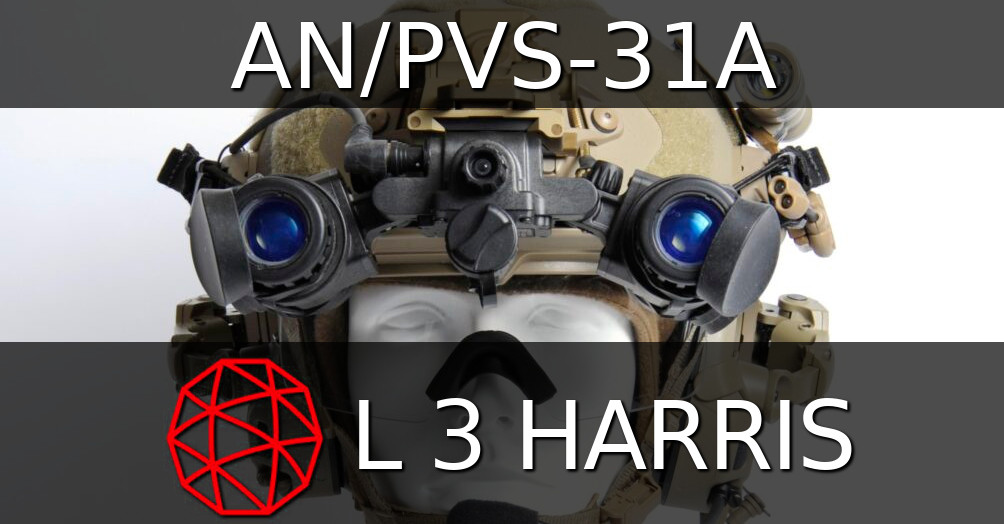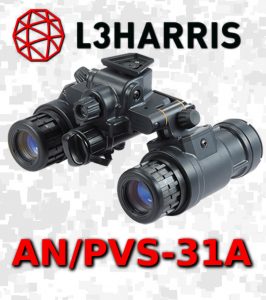The PVS 31 is a type of binocular night vision goggles (NVG) designed and constructed by L3 Harris. This gen 3 NVG is used by the US Military including special operations units. This newer technology replaced the outgoing (but still very capable) AN/PVS-15 for USSOCOM use. Although the PVS-31A (0.99 lbs) has a much narrower field of view than the L3Harris Ground Panoramic NVG (1.69 lbs), light weight and smaller size are still crucial factors to consider. When it comes to spec ops gear, night vision is one of the most iconic pieces of kit.
- Manufacturer and Country of Origin:
- L3 Harris Technologies, United States of America
- Weight:
- 0.99 lbs*
0.49kg*
*This weight includes one AA battery installed.How much a device weighs is crucial when choosing NODs. While a few ounces/grams may not seem like a lot to the casual user, experience teaches us otherwise. When NVGs are attached to a helmet and hang out in front of the user’s face, the moment of inertia and leverage created by the placement causes neck fatigue and can cause the helmet to shift on the user’s head. Turning one’s head to face potential threats becomes exponentially more difficult as weight increases.
For these reasons, light weight is one of the top performance features considered for military use.
- Size/Dimensions:
-
Length: 4.7 inches (11.9cm)
Width: 4.2 inches (10.7cm)
Height: 3.4 inches (8.6cm) - Battery & Run Time:
-
1 AA Battery will last 15 hours.
4 AA batteries (in a remote mount) will last 50 hours.With the rise of the lithium CR123, the choice to use less powerful and older a double A batteries may seem counterintuitive. However, AA batteries have the advantage of being easier to find and much cheaper to buy. The higher power output of CR123s can also be a problem for safe battery storage in bad environments or if spare batteries are stowed in pockets etc.
Also worth noting is that Gen 3 night vision consumes far less power than previous NODs, so the higher energy density of CR123 batteries is less important than it used to be. In austere environments where supplies are limited, it would probably be easier to find AA’s, so that’s also worth considering.
- Generation & Intensifier Tube Construction:
-
- Gen 3
- 18mm MX-11769 tube size
- PVS-31A: White Phosphorus Filmless
- PVS-31: Green Phosphorus
- Autogated
- 2376 Figure of Merit
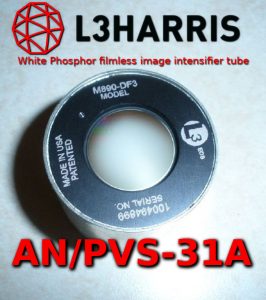
L3 Filmless White phosphor tubes are considered to be top performers in low light NVG performance. All night vision devices except for thermal require at least a tiny bit of ambient light to function. “Image intensifier tubes” take the minuscule ambient light from stars and amplify it so that humans can see by it. Modern Gen 3 NODs are so sensitive that they’re useful even with no moon and thick cloud cover. But, they wouldn’t be useful deep inside a cave without an external light source. “Filmless” technology allows these image intensifier tubes to work and have better clarity in lower low light scenarios when compared to thin-film or standard film construction.The convenient autogating feature blocks out glare from light sources, allowing the user to see into shadows despite photonic barriers.
The combination of filmless, autogated white phosphor technologies found in the A designation creates a state of the art experience that maximizes performance while minimizing glare and eye fatigue.
- Theaters of Conflict:
- Due to the classified nature of military technology, the exact point that Special Forces began using the AN/PS-31 is unknown. It is believed to have been widely used in the Global War On Terror, probably including areas like Afghanistan, Iraq and Yemen.
- Can civilians buy pvs 31?
- Yes, civilians can buy PVS-31. In February, 2021, this system became available for retail sale to US citizens, although it is still subject to ITAR (International Traffic in Arms Regulations) restrictions. Prior to this, a few lucky (and affluent) individuals managed to obtain gray market versions on the used market. The exact date that the pvs31 began service with US spec ops teams and other military units is unknown.
- Diopter & Focus:
-
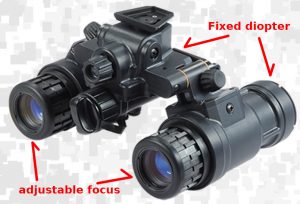
Diopter is fixed at -0.5, but can be changed at the factory a custom setting. Diopter is the refractive power of lenses equal to the reciprocal of the focal length measured in meters. This unit of measurement is used in prescription corrective glasses. In night vision devices, diopter is often adjustable so that users can fine tune their NVG to more precisely match their exact eye-sight.While its normally a valuable feature, the PVS31 eschews adjustable diopter does add weight, so it was removed from this model.
The focus of the lenses is manually adjustable from 18 inches (45.72cm) to infinity; this means that if you’re focused on targets at 20 yards (16.5 meters), objects up close may appear out of focus or blurry. Manual focus is often preferred because auto-focus systems don’t always zero in on the features that are most important to the wearer.
- Gain:
-
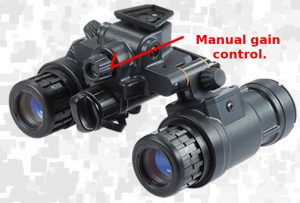 The PVS-31 features a manual gain.This means that it’s up to the user to adjust the brightness so they can see their environment clearly while also not being so bright that it becomes disorienting. While many people prefer an automated gain adjustment, there’s an argument to be made for the rugged simplicity of a manual gain system, especially when combined with autogated intensifier tubes.
The PVS-31 features a manual gain.This means that it’s up to the user to adjust the brightness so they can see their environment clearly while also not being so bright that it becomes disorienting. While many people prefer an automated gain adjustment, there’s an argument to be made for the rugged simplicity of a manual gain system, especially when combined with autogated intensifier tubes.
One other consideration is that on other units that have automatic gain control, the light sensor may become covered in dirt, grime or debris on the battlefield. A blocked or damaged light sensor could result in an automatic gain system becoming inoperable, at least until there was a lull in the fighting and the soldier had time to clean the device. - Field of View
-
40 degree FOV Standard:
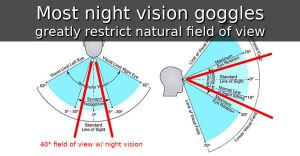 While there are DTNVG/BNVG systems with wider field of view standard, the narrower range of the PVS 31 has the benefit of reduced distortion at the periphery. Much more basic monocular units like the PVS-14 also feature a 40* field of view, so to spend 3x the money to not get a wider view might disappoint some buyers. However, the upside of this low FOV is that the image clarity is superior in terms of less distortion and increased resolution.
While there are DTNVG/BNVG systems with wider field of view standard, the narrower range of the PVS 31 has the benefit of reduced distortion at the periphery. Much more basic monocular units like the PVS-14 also feature a 40* field of view, so to spend 3x the money to not get a wider view might disappoint some buyers. However, the upside of this low FOV is that the image clarity is superior in terms of less distortion and increased resolution. 70 degree FOV Option (WFOV BNVD AN/PVS-31A):
There are less common versions of this unit called the “WFOV BNVD” (Wide Field Of View Binocular Night Vision) that mount the image intensifier tubes at an outward angle to increase the users’ field of view. This alternate layout is called a DITNVG (Diverging Image Tube Night Vision Goggle), which splays the tubes out such that the user gets a wider field of view. The benefit of a wider FOV is much greater situational awareness, but it comes with the downside of less clarity at the center of the user’s vision.For myself and my limited experience as a non-veteran civilian, I appreciate a wider field of view. My current NVG (ATN PS31-3w) features a 50* FOV and anything less than that feels like a big trade-off. I’d very much like to get my hands on a set of WFOV NODs for review, so if you have access to some please let me know.
